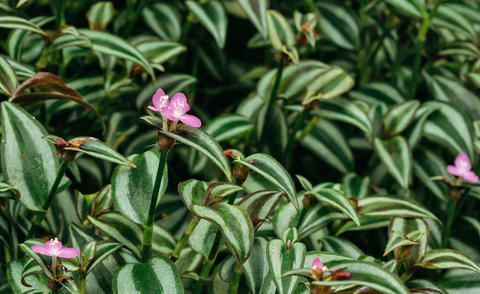Silver Inch Plant
The trailing shoots and decorative leaves of the silver inch plant look magnificent in a hanging basket. Find out how to care for the houseplant with the “zebra stripes”.
Factsheet
- Growth characteristics
-
- hanging
- sweeping
- Flower color
-
- pink
- white
- Flowering time (month)
-
- January to December
- Flower shape
-
- cup-shaped
- in leaf axils
- small
- Leaf color
-
- multicolored
- page format
-
- full margined
- pointed oval
- Sheet properties
-
- evergreen
- Fruit shape
-
- Capsule
- Fruit characteristics
-
- unimpressive
- Light
-
- scattered light
- Soil type
-
- loamy to clayey
- Soil Moisture
-
- fresh to moderately humid
- Lime compatibility
-
- sensitive to lime
- Nutrient requirements
-
- nutrient-rich
- Humus
-
- rich in humus
- Decorative or utility value
-
- Leaf ornaments
- picturesque growth
- Use
-
- Interior greening
- Planters
- Winter garden
- Warm House
- Garden style
-
- Pot garden
The Silver Inch Plant (Tradescantia zebrina), previously known as Zebrina pendula, belongs to the Spiderwort genus in the family Commelinaceae. It is native to Central and South America. As a houseplant, the silver inch plant tends to be grown in as it looks simply wonderful.
The silver inch plant is very popular as an ornamental foliage plant: It rarely forms flowers or produces fruit. It develops densely foliated creeping to trailing shoots with a highly ornamental value.
The pointed, ovate leaves of the silver inch plant are around 2.5 inches long and have “zebra stripes”. The plant takes its name from the two silvery white stripes on the surface of the leaf, which decoratively stand out from the dark green foliage. The undersides of the leaves are dark red.
The flowers appear in the leaf axils and are white to pink. The plant forms only a few flowers, but they appear all year round.

The plant forms small capsule fruits after flowering.
A bright, but partially shaded location and normal room temperature is all the silver inch plant needs. It should be kept slightly cooler in winter at 54 to 59 degrees Fahrenheit.
Regular potting soil is a suitable substrate. However, the silver inch plant can also be grown in hydroponics.
The root ball should always be kept slightly moist, even in winter. In very warm conditions, the silver inch plant should be sprayed from time to time, preferably with softened water.
The plant can be fertilized once a week during the vegetation period and once a month in winter. Simply add some plant fertilizer to the water.

The silver inch plant can be repotted between spring and fall.
The plant does not need pruning.
The variety ‘Quadricolor’ has unique ornamental foliage with a four-color leaf blade. The underside of the leaves of ‘Purpusii’ glow an intense pink, the entire upper side of the leaf has a pink tinge.
It’s a good idea to cultivate young plants, as the plant loses its leaves relatively quickly. Fortunately, they are very easy to propagate: Take some cuttings in spring or summer and put them in water. New and strong roots form after just a short time.
The silver inch plant is occasionally affected by aphids.

